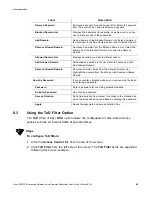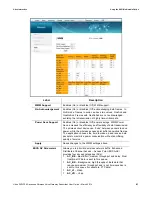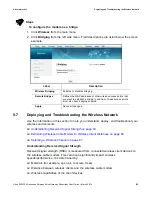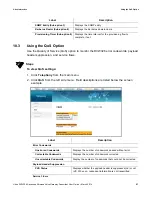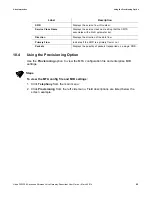
Ubee Interactive
Using the Advanced Option
Ubee DVW326 Advanced Wireless Voice Gateway Subscriber User Guide • March 2014
77
Label
Description
54g™ Mode
Selects the network mode in which to run the DVW326. The
options are:
54g auto – self adaptive connection
54g performance – highest speed
54g LRS – limited speed
802.11b – connections to 11b clients only.
This field can be set only if 802.11-n Mode is set to
Off
in the
Radio screen as discussed on
Using the Wireless Radio Option
on page 68
.
XPress™ Technology
Enables or disables the XPress feature. XPress™ is a
standards-based frame-bursting approach to improve 802.11g
wireless LAN performance developed by Broadcom. When
Xpress enabled, aggregate throughput can improve up to 27%
in 802.11g-only networks, and up to 75% in mixed networks
comprised of 802.11g and 802.11b standard equipment.
802.11n Protection
Defines the 802.11n Protection setting.
Auto
- the DVW326 uses Request to Send/Clear to Send
(RTS/CTS) to improve the performance in 802.11 mixed
environments.
Off
- the 802.11 performance is maximized under most
conditions, while the other 802.11 modes (802.11b, etc.) are
secondary.
Short Guard Interval
Defines a transmission interval so data transmissions do not
interfere with each other.
Basic Rate Set
Selects the rate that all wireless clients must support to connect
to the DVW326. The options are
All
and
Default
.
Multicast Rate
Specifies the rate at which multicast packets are transmitted and
received on your wireless network.
NPHY Rate
Sets the Physical Layer (NPHY) rate. Choose Legacy Rate to
use 802.11a or 802.11g modes, and then choose the rate in the
Legacy Rate field.
Legacy Rate
Sets the wireless rate to the chosen 802.11a or 802.11g legacy
rate.
Beacon Interval
Specifies the Beacon Interval from 100 to 6553 5ms. This value
indicates the frequency interval of the beacon. A beacon is a
packet broadcast by the DVW326 to keep the network
synchronized. A beacon includes information regarding the
wireless networks service area, the access point address, the
broadcast destination addresses, a time stamp, delivery traffic
indicator maps, and the Traffic Indicator Message (TIM).
DTIM Interval
Specifies the DTIM interval from 3 to 255ms. This value
indicates how often the DVW326 sends out a Delivery Traffic
Indication Message (DTIM). Lower settings result in more
efficient networking, while preventing your wireless clients from
dropping into power-saving sleep mode. Higher settings allow
your wireless clients to enter sleep mode, thus saving power,
but interferes with wireless transmissions.



